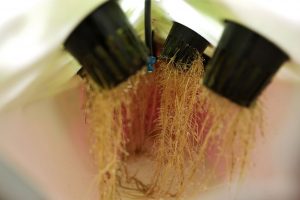Aeroponics is the process of growing plants in an air or mist environment without the use of soil or other medium
A gentle misting breeze of nutrients sprays across naked roots hanging in the air, as an aeroponics system produces food for the fans of all things tech. You may ask yourself, exactly what is aeroponics? The answer: It’s the process of growing plants in an air or mist environment without the use of soil or other medium. While aeroponics is a long way from being the norm, many growers do get a kick out of producing strawberries out of thin air.
In April 2020, industry leader AeroFarms announced plans to build the world’s largest indoor vertical farm at 90,000 square feet in Abu Dhabi, the capital of the United Arab Emirates. Complete with state-of-the-art indoor vertical farming technology using 95 percent less water and zero pesticides, the new facility is projected to employ more than 60 high-skilled roles, including horticulturalists, engineers and data scientists, with an advanced organoleptic research and precision phenotyping laboratory, advanced seed breeding center, phytochemical analysis laboratory, machine learning laboratory, and robotics automation and drones lab.
And more such developments are en route. Per the report “Aeroponics Farming Market 2019 Global Analysis, Growth, Trends and Opportunities Research Report Forecasting to 2024,” many futurists across the world envision aeroponics as a way to produce more food on less acreage, and when coupled with solar power, perhaps less energy. But downsides do exist, and at present, engineers are busy partnering with growers to reduce those and maximize efficiency.
Pros and cons of aeroponics explained
The obvious benefit to aeroponics is the volume of plants that can be grown year-round on a limited amount of space. Some systems growing tomatoes report as many as 7.7 crop turn-arounds per year, compared to 3.47 for traditional growing methods — greatly increasing poundage generated per plant. But simply hanging pots won’t be sufficient for the operation to work, and great care needs to be taken. As part of the overall system, each unique plant’s needs must be considered. Carbon, hydrogen and oxygen are present in both air and water, but both the Electrical Conductivity (EC) and the pH of their and water must vary by the plant. Most plants prefer a pH level around 6.0, and hard water tends to be around 8.0, meaning water softening systems would be required for operations where well water was being used. This is particularly important with an aeroponics system because the water will directly sprayed onto the roots and won’t have a soil surrounding it to serve as a buffer. Remember, pH is a logarithmic scale, not linear, meaning a move from 7.0 to 6.0 makes for 10 times the acidity.

The same care must be taken with the EC, as lettuce grows best with about 1.6. If the EC of the tap water being used in the operation is 0.3 before adding any nutrients, concocting a solution for the aeroponic system to raise it to 1.6 would mean nearly 19 percent of the things dissolved into the water would be things the plant doesn’t want. As every grower knows, primary plant nutrients include nitrogen, phosphorus and potassium, with secondary nutrients being calcium, magnesium, and sulfur, as well as iron, zinc, molybdenum, manganese, boron, copper, cobalt, and chlorine. But whereas traditional growers are used to relying on the Earth itself to supply a good portion of this, in an aeroponics system, the recipe for the roots must be created specifically for each plant in terms of type and stage. If this sounds like a lot of calculations, you’d be right.
And the same kind of consideration needs to be taken with regards to air quality, temperature, and light. Naked roots dangling in the air are much more susceptible to temperature at either extreme, as well as light, leading to a substantial amount of upfront costs relative to the scope of the operation.
But, the positives are enough to keep people moving forward. Once established, the aeroponics system can be adjusted to grow anything from greens to berries and tomatoes by simply adjusting the inputs. And with a vertical approach year-round, the volume possible makes investors dance. The lack of soil also affords a disease-free environment.
Aeroponics: Good for a test
Another big positive to aeroponics is that plenty of Do It Yourself kits are available for purchase online. You could start small in the spring while the weather is warm and determine whether you’d want to expand. But if the idea of fresh tomatoes in January appeals to you, the effort might be worth it.



